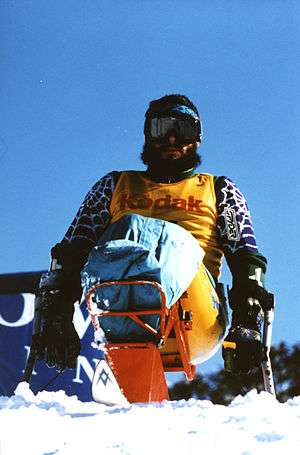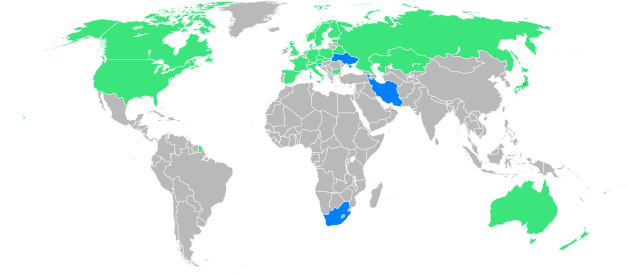Australia at the 1998 Winter Paralympics
| Australia at the 1998 Winter Paralympics | |||||||||
|---|---|---|---|---|---|---|---|---|---|
 | |||||||||
| IPC code | AUS | ||||||||
| NPC | Australian Paralympic Committee | ||||||||
| Website |
www | ||||||||
| in Nagano | |||||||||
| Competitors | 4 in 1 sport | ||||||||
| Flag bearer | James Patterson (Opening)[1] | ||||||||
| Medals Ranked 16th |
| ||||||||
| Winter Paralympics appearances (overview) | |||||||||
The 1998 Winter Paralympics were held in Nagano, Japan from the 5–14 March 1998.[2] At these Games, Australia was represented by four male alpine skiers and finished equal 16th (with Denmark) of 21 Nations on the overall medal tally.[3] James Patterson, an LW9 standing skier, won Australia's two medals - one gold and one bronze.[4]
The Team
Members of the 1998 Australian Winter Paralympic Team were nominated after a series of training camps and competition at the Disabled WinterSport Australia Nationals held in Mt Hotham, Victoria.[5] The team originally consisted of six alpine skiers.
| Athlete | Classification | Events | Previous Games | Competitive Status |
|---|---|---|---|---|
| Anthony Bonaccurso | LW11 | Men's Giant Slalom LW11
Men's Slalom LW11 Men's Super-G LW11 |
Nil | Competed |
| Rod Hacon | LW11/LWXII | Did not compete - Injury | 1992 Tignes-Albertville
1994 Lillehammer |
Withdrew - injury |
| David Munk | LW11/LWXII | Did not compete - Illness | 1988 Innsbruck
1992 Tignes-Albertville 1994 Lillehammer |
Withdrew - illness |
| Matthew Shane Nicholls | LW5/7 | Men's Downhill LW1,3,5/7,9
Men's Giant Slalom LW1,3,5/7 Men's Slalom LW6/8 Men's Super-G LW1,3,5/7 |
Nil | Competed |
| James Lawrence Patterson | LW9 | Men's Giant Slalom LW9
Men's Super-G LW9 Men's Slalom LW9 Men's Downhill LW1,3,5/7,9 |
1994 Lillehammer | Competed |
| Alastair Mars | LW6/8 | Men's Downhill LW6/8
Men's Giant Slalom LW6/8 Men's Slalom LW6/8 Men's Super-G LW6/8 |
Nil | Competed |

The team was supported by national head coach Steve Bova and managed by Commander Adrian Pay (RAN).[5]
Games Preparation
The Australian's began their team training in unsympathetic Australian ski conditions. Once the Australian ski fields proved inadequate for training the team travelled to the northern hemisphere where they spent a significant amount of time training and acclimatising prior to the Nagano Paralympics.[5]
Withdrawals
It was during this time that both Rod Hacon and David Munk were forced to withdraw from the Australian team. Munk became seriously ill with a kidney infection and Hacon suffered an freak accident, whilst carrying his ski, severely damaging his hand.[5] The injury required surgery and ongoing treatment. Consequently both experienced Paralympic campaigners withdrew from the team prior to the Games. This was a significant blow for the Australian team as they lost two of their most experienced Paralympians who were both well placed to medal at the Games. James Patterson was the only athlete left in the team with previous Paralympics experience. The Australian Winter Paralympic team was reduced to only four athletes, three of whom who'd never before competed at a Winter Paralympics.
Medalists
.jpg)
| Medal | Name | Sport | Event |
|---|---|---|---|
| | Patterson, JamesJames Patterson | Alpine Skiing | Men's Downhill LW1,3,5/7,9 |
| | Patterson, JamesJames Patterson | Alpine Skiing | Men's Slalom LW9 |
James Patterson performed strongly in the blue-ribbon event, the Men's Downhill and eclipsed the opposition,[5] beating New Zealander Mathew Butson to the gold medal by over a second.[4] After two bad races in the Giant Slalom and Super G, Patterson fought back to claim bronze in the Slalom LW9.[5]
Results
Alpine skiing
- Men
| Athlete | Event | Time | Factor % | Calculated Factor | Rank |
|---|---|---|---|---|---|
| Anthony Bonaccurso | Men's Giant Slalom LW11 | DNF | - | - | - |
| Men's Slalom LW11 | 2:57.26 | 72.63033 | 2:08.74 | 17 | |
| Men's Super-G LW11 | 2:07.03 | 83.15137 | 1:45.62 | 20 | |
| Matthew Shane Nicholls | Men's Downhill LW1,3,5/7,9 | 1:27.83 | 97.64023 | 1:25.75 | 10 |
| Men's Giant Slalom LW1,3,5/7 | 3:20.93 | 98.77309 | 3:18.46 | 6 | |
| Men's Slalom LW6/8 | DNF | - | - | - | |
| Men's Super-G LW1,3,5/7 | 1:39.37 | 99.03576 | 1:38.41 | 11 | |
| James Patterson | Men's Giant Slalom LW9 | 3:07.42 | 90.84983 | 2:50.27 | 4 |
| Men's Super-G LW9 | DSQ | - | - | - | |
| Men's Slalom LW9 | 2:08.01 | 88.6755 | 1:53.51 | ||
| Men's Downhill LW1,3,5/7,9 | 1:10.10 | 95.92812 | 1:07.24 | ||
| Alastair Mars | Men's Downhill LW6/8 | 1:12.65 | 100 | 1:12.65 | 16 |
| Men's Giant Slalom LW6/8 | DSQ | - | - | - | |
| Men's Slalom LW6/8 | DNF | - | - | - | |
| Men's Super-G LW6/8 | 1:23.64 | 100 | 1:23.64 | 20 | |
Medal Table
Australia finished equal 16th (with Denmark) of 21 Nations on the overall medal table.[3] This was lower than the previous two Winter Paralympic games. Australia finished ninth on the table in Lillehammer four years prior (nine medals - three gold, two silver and four bronze)[7] and twelfth in Albertville in 1992 (four medals - one gold, one silver and two bronze).[8]

| Rank | Country | Gold | Silver | Bronze | Total | |
|---|---|---|---|---|---|---|
| 1 | Norway | 18 | 9 | 13 | 40 | |
| 2 | Germany | 14 | 17 | 13 | 44 | |
| 3 | United States of America | 13 | 8 | 13 | 34 | |
| 4 | Japan | 12 | 16 | 13 | 41 | |
| 5 | Russia | 12 | 10 | 9 | 31 | |
| 6 | Switzerland | 10 | 5 | 8 | 23 | |
| 7 | Spain | 8 | 0 | 0 | 8 | |
| 8 | Austria | 7 | 16 | 11 | 34 | |
| 9 | Finland | 7 | 5 | 7 | 19 | |
| 10 | France | 5 | 9 | 8 | 22 | |
| 11 | New Zealand | 4 | 1 | 1 | 6 | |
| 12 | Italy | 3 | 4 | 3 | 10 | |
| 13 | Czech Republic | 3 | 3 | 1 | 7 | |
| 14 | Ukraine | 3 | 2 | 4 | 9 | |
| 15 | Canada | 1 | 9 | 5 | 15 | |
| 16 | Australia | 1 | 0 | 1 | 2 | |
| Denmark | 1 | 0 | 1 | 2 |
Impact
At the conclusion of the games, the Australian Paralympic Committee developed a plan to improve Australia's medal count at the Winter Paralympic Games. The entire winter program was reviewed resulting in a focus on talent identification, continuity of coaching and ongoing, well structured training . A year-round training program was developed to improve physical conditioning for skiing athletes. Funding was secured from the Australian Paralympic Committee, the Australian Sports Commission, and the New South Wales Department of Sport and Recreation.[5][10]
Ron Finneran of WinterSport Australia did a major push to help insure the success of this program. He helped to bring Perisher Blue and Thredbo, two Australian ski resorts, on board to provide training venues, access and support to Australian Paralympic skiers.[11]
See also
References
- ↑ "Inaugural Central Coast Sporting Wall of Fame - James Patterson". Blue Tongue Stadium Website. Retrieved 22 January 2013.
- ↑ "Nagano 1998 Paralympics - Ceremonies, Medals, Torch Relay". www.paralympic.org. Retrieved 2016-08-24.
- 1 2 3 Committee, Alexander Picolin, International Paralympic. "IPC Historical Results Archive - MedalStandings Web". db.ipc-services.org. Retrieved 2016-08-24.
- 1 2 3 4 "Paralympic Results & Historical Records". www.paralympic.org. Retrieved 2016-08-24.
- 1 2 3 4 5 6 7 8 Australian Paralympic Committee (1998). "1998 APC Annual Report". 1998 APC Annual Report. Australian Paralympic Committee. Retrieved 24 August 2016.
- ↑ Committee, Alexander Picolin, International Paralympic. "IPC Historical Results Archive - Competition Web". db.ipc-services.org. Retrieved 2016-08-24.
- ↑ Committee, Alexander Picolin, International Paralympic. "IPC Historical Results Archive - MedalStandings Web". db.ipc-services.org. Retrieved 2016-10-05.
- ↑ Committee, Alexander Picolin, International Paralympic. "IPC Historical Results Archive - MedalStandings Web". db.ipc-services.org. Retrieved 2016-10-05.
- ↑ Brittain, Ian (2014). From Stoke Mandeville to Sochi a history of the summer and winter paralympic games. Illinois: Common Ground Publishing. p. 211. ISBN 9781612294124.
- ↑ Australian Paralympic Committee (1999). "1999 APC Annual Report" (PDF). 1999 APC Annual Report. Australian Paralympic Committee. Retrieved 24 August 2016.
- ↑ "Sport Australia Hall of Fame - Member Profile". www.sahof.org.au. Retrieved 2016-08-24.